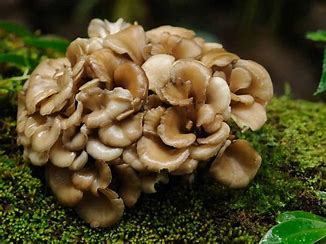Maitake mushrooms, also known as "hen of the woods" mushrooms, are a type of wild mushroom that is native to Asia and North America. They are highly regarded for their unique flavor, culinary versatility, and potential health benefits. Here's some information about Maitake mushrooms:
Appearance: Maitake mushrooms grow in large, clustered formations, resembling the appearance of a hen spreading its feathers, which is why they are sometimes called "hen of the woods." They have multiple overlapping, fan-shaped caps with a frilly or ruffled appearance. The color can range from pale to dark brown.
Flavor and Texture: Maitake mushrooms have a robust, earthy flavor and a firm, meaty texture. They are known for their rich umami taste, making them a popular choice in various dishes.
Culinary Uses: Maitake mushrooms are widely used in cooking and can be prepared in a variety of ways. They can be sautéed, roasted, grilled, or used in soups and stir-fries. Due to their substantial texture and strong flavor, they are often used as a meat substitute in vegetarian and vegan dishes. Maitake mushrooms are also popular in Japanese, Chinese, and Korean cuisines.
Nutritional Benefits: Maitake mushrooms are considered to be a nutritious food. They are a good source of vitamins, minerals, and antioxidants. Some studies suggest that they may have potential health benefits, such as supporting the immune system and reducing inflammation. They are also low in calories and fat.
Medicinal Uses: In traditional herbal medicine, Maitake mushrooms have been used for their potential health benefits. They are sometimes considered adaptogens, which are substances that may help the body adapt to stress and support overall health.
Availability: Maitake mushrooms are available in fresh or dried form. They can sometimes be found in specialty grocery stores, farmers' markets, or foraged in the wild. Dried Maitake mushrooms are often used to make Maitake mushroom extract or supplements.
When cooking with Maitake mushrooms, it's important to clean them thoroughly, as they can harbor debris. They are a delightful addition to many dishes, offering a unique and savory flavor. However, if you plan to forage for Maitake mushrooms in the wild, it's essential to be knowledgeable about wild mushroom identification and safety, as some mushrooms can be toxic.
Maitake mushrooms can be more expensive than common cultivated mushrooms, such as white button mushrooms or cremini mushrooms. The higher cost is due to several factors:
Rarity: Maitake mushrooms are not as widely cultivated as common mushrooms, which makes them less readily available. They are often found in the wild or grown by specialty mushroom growers. This limited availability contributes to their higher price.
Foraging: In some cases, Maitake mushrooms are foraged in the wild, and this can be a labor-intensive process. Foragers often need to search for these mushrooms in specific wooded areas, and the yield can be unpredictable, further driving up the cost.
Culinary Demand: Maitake mushrooms have gained popularity in gourmet and specialty cuisine due to their unique flavor and texture. As a result, they are often in demand in high-end restaurants and gourmet food markets, leading to a premium price tag.
Nutritional and Medicinal Value: Maitake mushrooms are sometimes sought after for their potential health benefits, which can also contribute to their higher cost, especially when they are used for making supplements or extracts.








